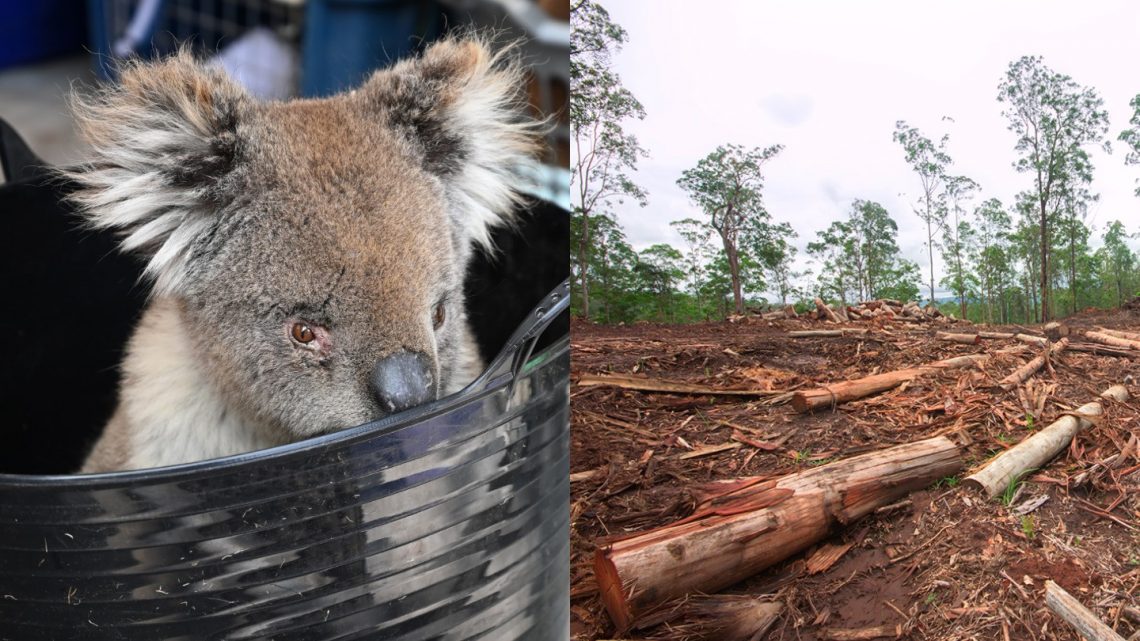
Koala Habitats that Survived Australia’s Bushfires are Now Being Logged
August 12, 2020Conservationists and wildlife experts have expressed grave concern that Australian state governments are continuing to log unburned forests that are home to vulnerable koala populations.
Estimates suggest that at least 5,000 koalas were killed and over 2 million hectares of habitat was destroyed in the state of New South Wales during the 2019/20 bushfires—a devastating blow to a species that is already facing the compounding risks of climate change, urban development and deforestation.
In light of these threats, a recent government inquiry found that the state’s koalas could become extinct by 2050 unless there is urgent government intervention to prevent habitat loss.
Yet despite a number of clear recommendations from that same inquiry—that the NSW government urgently prioritise the protection of koala habitat in urban planning, for example, and that they ban the opening up of old growth forests to logging—the state-owned logging agency Forestry Corporation is continuing to cut down trees in increasingly rare koala habitats.
“It’s a scandal that the government isn’t doing what’s required to prevent the extinction of one of our most iconic species,” James Tremain, from the Nature Conservation Council of NSW, told Vice News over the phone. “They’re schizophrenic on the issue. They say they have a koala strategy and an ambition to increase the population of koalas, but they’ve introduced laws that have made it much easier to destroy koala habitat.”
The recent bushfires destroyed millions of hectares of native bushland, but the NSW government has largely maintained the intensity of its logging operations: pledging to maintain wood supply at the same rate as before the disaster. As Tremain explained, that effectively means more intense logging operations across the state as corporations try to yield the same volume of timber from a significantly reduced area of bushland.
Forestry Corporation documents released through parliamentary processes showed that 85 percent of forest previously designated for logging on NSW’s south coast was burned in the bushfires, along with about 44 percent on the north coast. In response, the Forestry Corporation increased its logging intensity to keep up with the demand for timber.
The Nature Conservation Council of NSW previously asked the NSW Environment Protection Authority (EPA) to investigate the logging, but was told that operations could not be halted when Forestry Corporation was not in breach of its approvals.
“Unfortunately for koalas, they tend to like the same kinds of trees that loggers like—so they’re in direct competition,” he said. “The main extinction pressure that’s placed on koalas is habitat loss, primarily from logging for timber production or land clearing for agriculture. And although there is a desire for the government to do the right thing, there are powerful industry interests to prevent it from doing what has to be done.”
Video footage recorded by arborist and conservationist Kailas Wild reveals that logging operations are continuing in some of the last remaining koala habitats in NSW, in the Lower Bucca State Forest on the state’s north coast. Wild, who’s worked in koala conservation since 2010, understands the ramifications that deforestation can inflict on biodiverse ecosystems—and he fears the government’s business as usual approach could be devastating to already vulnerable wildlife populations.
“The fact that there’s just been no pause or stocktake from the NSW Government to be like ‘let’s just see whether this is going to cause impact’ is worrying,” he told Vice News. “These bushfires completely changed the game. I've seen with my own eyes the old growth forest that fires completely obliterated, and the habitat that no longer exists, and it’s really shifted and increased the value of these native forests.”
Wild further noted that he’s worried the remaining koala populations in NSW and Australia are even less than we think—and that if the NSW government and state premier Gladys Berejiklian continue to neglect meaningful action on wildlife protection and habitat preservation, the extinction of koalas in the state could come even sooner than current projections suggest.
“The fear is that 2050 is an optimistic estimate,” he said.
Associate Professor Mathew Crowther, from the University of Sydney’s School of Life and Environmental Sciences, said that although it is unlikely the whole koala species will go extinct in the near future, continued logging, habitat loss and fragmentation in areas where koalas live could increase the probability of localised extinction—that is, the loss of koalas from certain areas.
“It all depends on the amount of koala habitat that is to be logged, and what appropriate mitigation has been applied to maintain koalas in the area,” he told Vice News over email. “The Berejiklian government unfortunately has a very poor record regarding habitat and threatened species protection, and weakening of environmental legislation has led to greatly increased land clearing.”
Professor Crowther said that in order to effectively mitigate risks to koala populations, governments need to stop the fragmentation of their habitats, reduce developments near areas of koala populations, invest in research addressing threats to koalas, and implement policies to target some of those other threats, such as climate change.
In the short-term, though, with Australia still reeling in the aftermath of the most devastating fire season on record, he suggested that logging corporations should refrain from wading into potentially fragile ecosystems.
“Any logging of koala habitat at this time, when the full extent of the bushfires on koala and other species populations has yet to be ascertained, is short-sighted and potentially very damaging to the species,” he said.
Vice News approached the NSW Forestry Corporation for comment, but did not receive a response by the time of publication.

